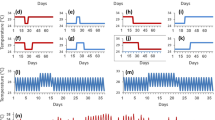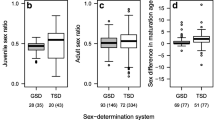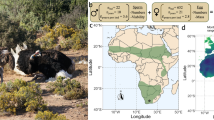Abstract
In species with temperature-dependent sex determination (TSD), global climate change may result in a strong sex ratio bias that could lead to extinction. The relationship between sex ratio and egg incubation at constant temperature in TSD species is characterized by two parameters: the pivotal temperature (P) and the transitional range of temperature that produces both sexes (TRT). Here, we show that the proportion of nests producing both sexes is positively correlated to the width of the TRT by a correlative approach from sex ratio data collected in the literature and by simulations of TSD using a mechanistic model. From our analyses, we predict that species with a larger TRT should be more likely to evolve in response to new thermal conditions, thus putting them at lower risk to global change.




Similar content being viewed by others
References
Akaike H (1974) A new look at the statistical model identification. IEEE Trans Automat Contr 19:716–723
Bell G, Collins S (2008) Adaptation, extinction and global change. Evol Appl 1:3–16
Binckley CA, Spotila JR, Wilson KS, Paladino FV (1998) Sex determination and sex ratios of pacific leatherback turtles, Dermochelys coriacea. Copeia 2:291–300
Bowden RM, Ewert MA, Nelson CE (2000) Environmental sex determination in a reptile varies seasonally and with yolk hormones. Proc R Soc London B Biol Sci 267:1745–1749
Bowden RM, Harms HK, Paitz RT, Janzen FJ (2004) Does optimal egg size vary with demographic stage because of a physiological constraint? Funct Ecol 18:522–529
Bull JJ (1980) Sex determination in reptiles. Q Rev Biol 55:3–21
Bull JJ (1983) Environmental sex determination (ESD). Evolution of sex determining mechanisms. Benjamin-Cummings, Menlo Park, CA
Bull JJ (1985) Sex ratio and nest temperature in turtles: comparing field and laboratory data. Ecology 66:1115–1122
Bull JJ, Vogt RC (1979) Temperature-dependent sex determination in turtles. Science 206:1186–1188
Bull JJ, Vogt RC, Bulmer MG (1982a) Heritability of sex ratio in turtles with environmental sex determination. Evolution 35:333–341
Bull JJ, Vogt RC, McCoy CJ (1982b) Sex determining temperatures in turtles: a geographic comparison. Evolution 36:13–26
Davenport J (1997) Temperature and the life-history strategies of sea turtles. J Therm Biol 22:479–488
De Souza RR, Vogt RC (1994) Incubation temperature influences sex and hatchling size in the neotropical turtle Podocnemis unifilis. J Herpetol 28:453–464
Delmas V, Prévot-Julliard A-C, Pieau C, Girondot M (2008) A mechanistic model of temperature-dependent sex determination in a Chelonian, the European pond turtle. Funct Ecol 22:84–93
Demuth JP (2001) The effects of constant and fluctuating incubation temperatures on sex determination, growth, and performance in the tortoise Gopherus polyphemus. Can J Zool 79:1609–1620
Doody S, Guarino E, Georges A, Corey B, Murray G, Ewert MA (2006) Nest site choice compensates for climate effects on sex ratio in a lizard with environmental sex determination. Evol Ecol 20:307–330
Eendebak BT (1995) Incubation period and sex ratio of Hermann’s Tortoise. Chelonian Conserv Biol 1:227–231
Etchberger CR, Ewert MA, Raper BA, Nelson CE (1992) Do low incubation temperatures yield females in painted turtles? Can J Zool 70:391–394
Ewert MA, Nelson CE (1991) Sex determination in turtles: diverse patterns and some possible adaptive values. Copeia 1:50–69
Ewert MA, Jackson DR, Nelson CE (1994) Patterns of temperature-dependent sex determination in turtles. J Exp Zool 270:3–15
Ewert MA, Etchberger CR, Nelson CE (2004a) Turtle sex-determination modes and TSD patterns, and some TSD pattern correlates. In: Valenzuela N, Lance VA (eds) Temperature-dependent sex determination in vertebrates. Smithsonian Books, Washington, DC, pp 21–32
Ewert MA, Hatcher RE, Goode JM (2004b) Sex determination and ontogeny in Malacochersus tornieri, the Pancake tortoise. J Herpetol 38:291–295
Ewert MA, Lang JW, Nelson CE (2005) Geographic variation in the pattern of temperature-dependent sex determination in the American snapping turtle (Chelydra serpentina). J Zool Lond 265:81–95
Freedberg S, Wade MJ (2001) Cultural inheritance as a mechanism for population sex-ratio bias in reptiles. Evolution 55:1049–1055
Georges A, Limpus CJ, Stoutjestjik R (1994) Hatchling sex in the marine turtle Caretta caretta is determined by proportion of development at a temperature, not daily duration of exposure. J Exp Zool 270:432–444
Georges A, Doody S, Beggs K, Young JE (2004) Thermal models of TSD under laboratory and field conditions. In: Valenzuela N, Lance VA (eds) Temperature-dependent sex determination in vertebrates. Smithsonian Books, Washington, DC, pp 79–89
Georges A, Beggs K, Young JE, Doody S (2005) Modelling development of reptile embryos under fluctuating temperature regimes. Physiol Biochem Zool 78:18–30
Girondot M (1999) Statistical description of temperature-dependent sex determination using maximum likelihood. Evol Ecol Res 1:479–486
Girondot M, Delmas V, Rivalan P, Courchamp F, Prévot-Julliard A-C, Godfrey MH (2004) Implication of temperature-dependent sex determination for population dynamics. In: Valenzuela N, Bull JJ (eds) Temperature-dependent sex determination. Smithsonian Books, Washington, pp 148–155
Glen F, Mrosovsky N (2004) Antigua revisited: the impact of climate change on sand and nest temperatures at a hawksbill turtle (Eretmochelys imbricata) nesting beach. Glob Chang Biol 10:2036–2045
Godfrey MH, Mrosovsky N (2006) Pivotal temperature for green turtles, Chelonia mydas, nesting in Suriname. Herpetol J 16:55–61
Godfrey MH, Barreto R, Mrosovsky N (1996) Estimating past and present sex ratios of sea turtles in Suriname. Can J Zool 74:267–277
Godfrey MH, D’Amato AF, Marcovaldi MÂ, Mrosovsky N (1999) Pivotal temperature and predicted sex ratios for hatchling hawksbill turtles from Brazil. Can J Zool 77:1465–1473
Godfrey MH, Delmas V, Girondot M (2003) Assessment of patterns of temperature-dependent sex determination using maximum likelihood model selection. Ecoscience 10:265–272
Gutzke WHN, Paukstis GL (1983) Influence of the hydric environment on sexual differentiation of turtles. J Exp Zool 226:467–469
Hawkes LA, Broderick AC, Godfrey MH, Godley BJ (2007) Investigating the potential impacts of climate change on a marine turtle population. Glob Chang Biol 13:923–932
Hoerl AE, Kennard RW (1970) Ridge regression: biased estimation for nonorthogonal problems. Technometrics 12:55–67
Hulin V, Girondot M, Godfrey MH, Guillon J-M (2008) Mixed and uniform brood sex ratio strategy in turtles: the facts, the theory and their consequences. In: Wyneken J, Bels V, Godfrey MH (eds) Turtles: from structures to strategies of life. CRC, Boca Raton, pp 279–300
Hurvich CM, Tsai C-L (1989) Regression and time series model selection in small samples. Biometrika 76:297–307
IPCC (2007) Climate Change 2007: the physical basis. Contribution of Working Group I to the fourth assessment. Report of the intergovernmental panel on climate change. Cambridge University Press, Cambridge
Janzen FJ (1992) Heritable variation for sex ratio under environmental sex determination in the common snapping turtle (Chelydra serpentina). Genetics 131:155–161
Janzen FJ (1994) Climate change and temperature-dependent sex determination in reptiles. Proc Natl Acad Sci USA 91:7487–7490
Jump AS, Penuelas J (2005) Running to stand still: adaptation and the response of plants to rapid climate change. Ecol Lett 8:1010–1020
Lang JW, Andrews HV (1994) Temperature-dependent sex determination in crocodilians. J Exp Zool 270:28–44
Lewis-Winokur V, Winokur RM (1995) Incubation temperature affects sexual differentiation, incubation time, and posthatchling survival in desert tortoise (Gopherus agassizi). Can J Zool 73:2091–2097
Limpus CJ, Reed PC, Miller JD (1985) Temperature dependent sex determination in Queensland sea turtles: intraspecific variation in Caretta caretta. In: Grigg G, Shine R, Ehmann H (eds) Biology of Australasian frogs and reptiles. Royal Zoological Society, Sydney, pp 343–351
Marcovaldi MÂ, Godfrey MH, Mrosovsky N (1997) Estimating sex ratios of loggerhead turtles in Brazil from pivotal incubation durations. Can J Zool 75:755–770
Maxwell JA, Motara MA, Frank GH (1988) A micro-environmental study of the effect of temperature on the sex ratios of the loggerhead turtle, Caretta caretta, from Tongaland, Natal. S Afr J Zool 23:342–350
McCoy CJ, Vogt RC, Censky EJ (1983) Temperature-controlled sex determination in the sea turtle Lepidochelys olivacea. J Herpetol 17:404–406
Miller D, Summers J, Silber S (2004) Environmental versus genetic sex determination: a possible factor in dinosaur extinction? Fertil Steril 81:954–964
Morjan CL (2003a) How rapidly can maternal behavior affecting primary sex ratio evolve in a reptile with environmental sex determination? Am Nat 162:205–219
Morjan CL (2003b) Variation in nesting patterns affecting nest temperatures in two populations of painted turtles (Chrysemys picta) with temperature-dependent sex determination. Behav Ecol Sociobiol 53:254–261
Mrosovsky N (1982) Sex ratio bias in hatchling sea turtles from artificially incubated eggs. Biol Conserv 23:309–314
Mrosovsky N (1988) Pivotal temperatures for loggerhead turtles (Caretta caretta) from northern and southern nesting beaches. Can J Zool 66:661–669
Mrosovsky N, Benabib M (1990) An assessment of 2 methods of sexing hatchling sea-turtles. Copeia 2:589–591
Mrosovsky N, Provancha J (1989) Sex ratio of loggerhead sea turtles hatching on a Florida beach. Can J Zool 67:2533–2539
Mrosovsky N, Provancha J (1992) Sex ratio of hatchling loggerhead sea turtles: data and estimates from a 5-year study. Can J Zool 70:530–538
Mrosovsky N, Dutton PH, Whitmore CP (1984a) Sex-ratios of two species of sea turtle nesting in Suriname. Can J Zool 62:2227–2239
Mrosovsky N, Hopkins-Murphy SR, Richardson JE (1984b) Sex ratios of sea turtles: seasonal changes. Science 225:739–741
Mrosovsky N, Bass A, Corliss LA, Richardson JI, Richardson TH (1992) Pivotal and beach temperatures for hawksbill turtles nesting in Antigua. Can J Zool 70:1920–1925
Mrosovsky N, Baptistotte C, Godfrey MH (1999) Validation of incubation duration as an index of the sex ratio of hatchling sea turtles. Can J Zool 77:831–835
Mrosovsky N, Kamel SJ, Rees AF, Margaritoulis D (2002) Pivotal temperature for loggerhead turtles (Caretta caretta) from Kyparissia Bay, Greece. Can J Zool 80:2118–2124
Nelson NJ, Thompson MB, Pledger S, Keall SN, Daugherty CH (2004) Do TSD, sex ratios, and nest characteristics influence the vulnerability of tuatara to global warming? Int Congr Ser 1275:250–257
Packard GC, Packard MJ, Birchard GF (1989) Sexual-differentiation and hatching success by painted turtles incubating in different thermal and hydric environments. Herpetologica 45:385–392
Parmesan C (2006) Ecological and evolutionary responses to recent climate change. Annu Rev Ecol Evol Syst 37:637–669
Pertoldi C, Bach LA (2007) Evolutionary aspects of climate-induced changes and the need for multidisciplinarity. J Therm Biol 32:118–124
Pieau C (1971) Sur la proportion sexuelle chez les embryons de deux Chéloniens (Testudo graeca L. et Emys orbicularis L.) issues d’oeufs incubés articifiellement. C R Acad Sci Paris 272:3071–3074
Pieau C (1972) Effets de la température sur le développement des glandes génitales chez les embryons de deux chéloniens, Emys orbicularis L. et Testudo graeca L. C R Acad Sci Paris 274:719–722
Pieau C (1975) Temperature and sex differentiation in embryos of two Chelonians, Emys orbicularis L. and Testudo graeca L. In: Reinboth R (ed) Intersexuality in the Animal Kingdom. Springer, New York, pp 332–339
Pieau C (1982) Modalities of the action of temperature on sexual differentiation in field-developing embryos of the European pond turtle Emys orbicularis (Emydidae). J Exp Zool 220:353–360
Pieau C, Girondot M, Desvages G, Dorizzi M, Richard-Mercier N, Zaborski P (1994) Environmental control of gonadal differentiation. In: Short RV, Balaban E (eds) The differences between the sexes. Cambridge University Press, Cambridge, pp 433–448
Pieau C, Dorizzi M, Richard-Mercier N, Desvages G (1999) Sexual differentiation of gonads as a function of temperature in the turtle Emys orbicularis: Endocrine function, intersexuality and growth. J Exp Zool 281:400–408
Raynaud A, Pieau C (1985) Embryonic development of the genital system. In: Gans C, Billett FS (eds) Biology of the reptilia. Wiley, New York, pp 149–300
Rhen T, Lang JW (1998) Among-family variation for environmental sex determination in reptiles. Evolution 52:1514–1520
Rimblot F, Fretey J, Mrosovsky N, Lescure J, Pieau C (1985) Sexual differentiation as a function of the incubation temperature of eggs in the sea-turtle Dermochelys coriacea (Vandelli, 1761). Amphib-Reptil 6:83–92
Rimblot-Baly F, Lescure J, Fretey J, Pieau C (1987) Sensibilité à la température de la différenciation sexuelle chez la tortue luth, Dermochelys coriacea (Vandelli, 1761); application des données de l’incubation artificielle à l’étude de la sex-ratio dans la nature. Ann Sci Nat Zool Paris 8:277–290
Spotila JR et al (1994) Effects of incubation conditions on sex determination, hatching success, and growth of hatchling desert tortoises, Gopherus agassizii. Herpetol Monogr 8:103–116
Stainforth D et al (2005) Uncertainty in predictions of the climate response to rising levels of greenhouse gases. Nature 433:403–406
Sugiura N (1978) Further analysis of the data by Akaike’s information criterion and the finite corrections. Commun Stat A 7:13–26
Vaillant S, Dorizzi M, Pieau C, Richard-Mercier N (2001) Sex reversal and aromatase in chicken. J Exp Zool 290:727–740
Valenzuela N (2001) Constant, shift, and natural temperature effects on sex determination in Podocnemis expansa turtles. Ecology 82:3010–3024
Valenzuela N (2004) Introduction. In: Valenzuela N, Lance VA (eds) Temperature-dependent sex determination in vertebrates, vol 1. Smithsonian Books, Washington, DC, pp 1–4
Valenzuela N, Botero R, Martinez E (1997) Field study of sex determination in Podocnemis expansa from Colombian Amazonia. Herpetologica 53:390–398
Viets BE, Ewert MA, Talent G, Nelson CE (1994) Sex-determining mechanisms in squamate reptiles. J Exp Zool 270:45–56
Vogt RC, Flores Villela O (1992) Effects of incubation temperature on sex determination in a community of Neotropical freshwater turtles in southern Mexico. Herpetologica 48:265–270
Walther G-R et al (2002) Ecological responses to recent climate change. Nature 416:389–395
Weishampel J, Bagley DA, Ehrhart LM, Rodenbeck B (2003) Spatiotemporal patterns of annual sea turtle nesting behaviors along an East Central Florida beach. Biol Conserv 110:295–303
Whitmore CP, Dutton PH, Mrosovsky N (1985) Sexing of hatchling sea turtles—gross appearance versus histology. J Herpetol 19:430–431
Wibbels T, Killebrew FC, Crews D (1991) Sex determination in Cagle’s map turtle: implications for evolution, development, and conservation. Can J Zool 69:2693–2696
Wibbels T, Rostal DC, Byles R (1998) High pivotal temperature in the sex determination of the olive ridley sea turtle, Lepidochelys olivacea, from Playa Nancite, Costa Rica. Copeia 1998:1086–1088
Yntema CL, Mrosovsky N (1982) Critical periods and pivotal temperatures for sexual differentiation in loggerhead sea turtles. Can J Zool 60:1012–1016
Zwiers FW (2002) The 20-year forecast. Nature 416:690–691
Acknowledgments
The authors would like to thank Allen Foley, Brendan Godley, Marion Hulin and two anonymous reviewers for valuable comments. This work complies with the current laws of the country in which it has been performed.
Author information
Authors and Affiliations
Corresponding author
Additional information
Communicated by Herwig Leirs.
Rights and permissions
About this article
Cite this article
Hulin, V., Delmas, V., Girondot, M. et al. Temperature-dependent sex determination and global change: are some species at greater risk?. Oecologia 160, 493–506 (2009). https://doi.org/10.1007/s00442-009-1313-1
Received:
Accepted:
Published:
Issue Date:
DOI: https://doi.org/10.1007/s00442-009-1313-1




